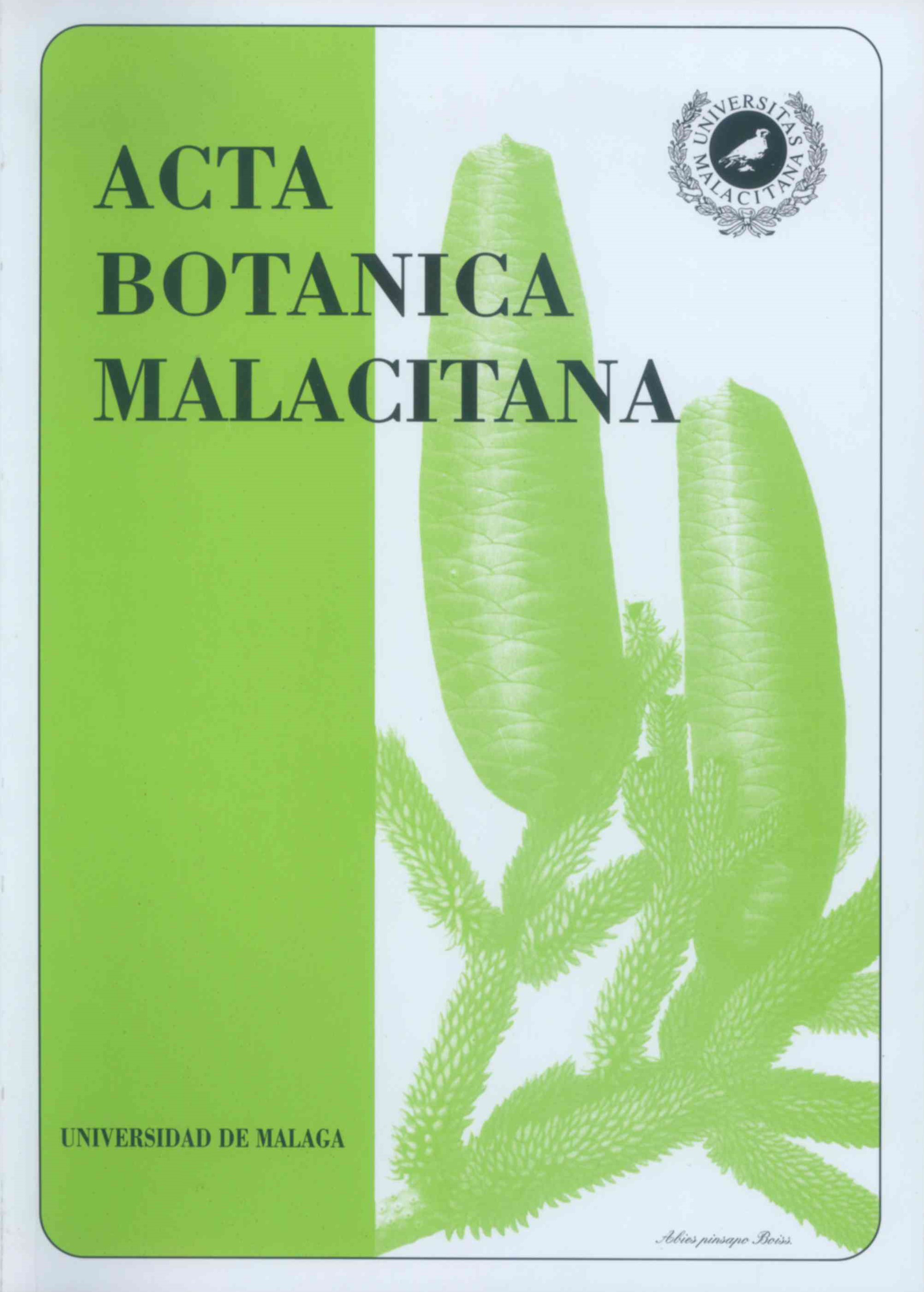Producción de néctar en matorrales del Sur de España. (Andalucía)
DOI :
https://doi.org/10.24310/abm.v20i.8840Mots-clés :
Melitopalinología, néctar floral, Andalucía, EspañaRésumé
Con el fin de evaluar los recursos alimenticios de Apis mellifera, se ha realizado un estudio de la producción de néctar de las especies más representativas de un matorral desarrollado en la Sierra de Mijas (Málaga, S de España). La producción de azúcar por flor/especie se ha calculado en función del volumen de néctar y su concentración en azúcares. La producción de azúcar por m 2/especie se ha calculado en función de la producción de flores por m 2/año. En 66 de las 115 especies estudiadas se ha detectado la presencia de néctar, cuantificándose la cantidad de azúcar en 49 de ellas.
Téléchargements
Métriques
Références
BOLTEN, A.B., P. FEINSINGER, H.G. HERBERT y I. BAKER -1979- On the calculation of sugar concentration in flower nectar. Oecologia, 41: 301-304.
BOND, H.W. y W.L. BROWN -1979- The explotation of floral nectar in Eucalyptus incrassata by honeyeaters and honeybees. Oecologia, 44: 105-111.
BOSCH, J. -1992- Floral biology and pollinators of three co-occurring Cistus species (Cistaceae). Botanical Journal of the Linnean Society, 109(1): 39-55.
BRANDT, U. & G. GOTTSBERGER -1988- Flower phenology, pollinating insects and breeding systems in Cistus, Halimium and Tuberaria species in Portugal. Lagascalia, 15: 625-634.
CORBET, S.A. -1978- Bee visits and the nectar of Echium vulgare L. and Sinapis alba L. Ecol. Entomol., 3: 25-27.
CORBET, S.A., C.J.C. KERSLAKE, D. BROWN y N.E. MORLAND -1984- Can bees select nectarrich flowers in patch?. J. Apic. Res., 23(4): 234- 242.
CORBET, S.A., D.M. UNWIN y O.E. PRYS-JONES -1979a- Humidity, nectar and insect visits to flowers, with special reference to Crataegus, Tilia and Echium. Ecol. Entomol., 4: 9-22.
CORBET, S.A., P.G. WILLMER, J.W.L. BEAMENT, D.M. UNWIN y O.E. PRYS-JONES -19796- Post-secretory determinants of sugar concentration in nectar. Plant Cell and Environment, 2: 293-308.
CORBET, S.A., P.G. WILLMER, J.W.L. BEAMENT, D.M. UNWIN y O.E. PRYS-JONES -1979b- Post-secretory determinants of sugar concentration in nectar. Plant Cell and Environment, 2: 293-308.
CRUDEN, R.W. y S.M. HERMANN -1983- Studying nectar? Some observations on the art. En B. BENTLEY y T. ELIAS (eds.). The biology of nectaries., Columbia University Press. New York.
DEVESA, JA., J. ARROYO y J. HERRERA -1985- Contribución al conocimiento de la biología floral del género Lavandula L. Anales Jard. Bot. Madrid, 42(1): 165-186.
FERNANDEZ, C., A. MUÑOZ y J.A. DEVESA -1989- Las digitalis extremeñas. Vida apicola, 35: 27-33.
HERRERA, J. -1985a- Biología reproductiva del matorral de Doñana. Tesis Doctoral. Universidad de Sevilla.
HERRERA, J. -19856- Nectar secretion patterns in southern spanish mediterranean shrublands. Israel J. Bot., 34: 47-58.
HERRERA, J. -1987a- Biología reproductiva de algunas especies del matorral de Doñana. Anales Jard. Bat. Madrid, 44(2): 483-497.
HIDALGO, M.I y B. CABEZUDO -1994- Fenología y volumen de floración del matorral de la Sierra de Mijas (Málaga, SE España). Acta Bot. Malacitana, 19: 123-136.
HIDALGO, M.I. y B. CABEZUDO -1995- Producción floral en un matorral del S de España como base para su valoración melitopalinológica. Anales Jard. Bot Madrid, (en prensa).
INOUYE, D.W., N.D. FAVRE, J.A. LANUN, D.M. LEVINE, J.B. MEYERS, M.S. ROBERTS, F.C. TSAO y Y.Y. WANG -1980- The effects of nonsugar nectar constituents on estimates of nectar energy content. Ecology, 61(4): 992-997.
MUÑOZ, A. y J.A DEVESA -1987- Contribución al conocimiento de la biología floral del género Lavandula L. II. Lavandula stoechas L. subsp. stoechas. Anales Jard. Bot. Madrid, 44(1): 63- 78.
NUÑEZ, J. -1977- Nectar flow by melliferous flora and gathering flow by Apis mellifera ligustica. J. Insect Physiol., 23: 265-275.
ORTIZ, P. -1991- Melitopalinología en Andalucia Occidental. Tesis Doctoral. Universidad de Sevilla.
ORTIZ, P.L. -1994- The Cistaceae as food resources for honey bees in SW Spain. Journ. Apic. Research, 33(3): 136-144.
PERCIVAL, M. -1961- Types of nectar in Angiospermas. New Phytol., 60: 235-281.
PERCIVAL, M. -1961- Types of nectar in Angiospermas. New Phytol., 60: 235-281.
PERCIVAL, M. -1961- Types of nectar in Angiospermas. New Phytol., 60: 235-281.
PFLUMM, W. -1985- Influence of nectar-supply rate on the number of flowers visited by a honeybee on each collecting flight. Oecologia, 66: 207-210.
SHUEL, R.W. -1975- La producción de néctar. In DADANT et al. (eds) La colmena y la abeja melifera. Hemisferio Sur. Montevideo.
TALAVERA, S., J. HERRERA, J. ARROYO, P.L. ORTIZ y J.A. DEVESA -1988- Estudio de la flora apícola de Andalucía Occidental. Lagascalia, 15(extra): 567-591.
TALAVERA, S., P.E. GIBBS & J. HERRERA - 1993- Reproductive biology of Cistus ladanifer (Cistaceae) Pl. Syst. Ecol., 186: 123-134.
WEBER EL-GHOBARY, M.O. -1984- Observation of flowering, pollen, nectar and pollen loads, due to Apis mellifera in some mediterranean plants. Les colloques de e'INRA, 21: 245-250.
WILLMER, P.G. -1980- The effects of insect visitor on nectar constituents in temperature plants. Oecologia, 47: 270-277.
Téléchargements
Publiée
Comment citer
Numéro
Rubrique
Licence
Les auteurs qui ont des publications avec cette revue acceptent les termes suivants:
a. Les auteurs conserveront leurs droits d'auteur et garantiront à la revue le droit de première publication de leur travail, qui sera simultanément soumis à la licence Creative Commons Attribution-Non-Commercial 4.0 dont le texte intégral se trouve sur <http: // creativecommons .org / licences / by-nc / 4.0> qui permet à des tiers de partager l'œuvre tant que son auteur et sa première publication sont indiqués, et tant que ce n'est pas à des fins commerciales.
b. Les auteurs peuvent adopter d'autres accords de licence non exclusifs pour la distribution de la version de l'œuvre publiée (par exemple, la déposer dans une archive télématique institutionnelle ou la publier dans un volume monographique) à condition que la publication initiale dans cette revue soit indiquée .
c. Les auteurs sont autorisés et recommandés à diffuser leur travail sur Internet (par exemple, dans les archives télématiques institutionnelles ou sur leur site Web) avant et pendant le processus de soumission, ce qui peut produire des échanges intéressants et augmenter les citations. des travaux publiés. (Voir L'effet de l'accès ouvert).







1.png)
